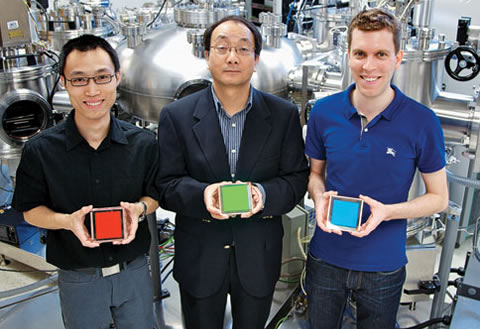U of T researchers have discovered a better way to make flat-panel displays that could one day lead to computer screens you roll up like a newspaper and wallpaper that lights your living room.
Michael Helander and Zhibin Wang, PhD candidates in the Faculty of Applied Science and Engineering, are members of a research team that has developed the world’s most efficient organic light-emitting diodes (OLEDs) on flexible plastic. Good news for manufacturers and consumers alike, the discovery means a less costly, more efficient and environmentally friendly way to build brighter flat-panel displays on a thinner, more durable and flexible surface.
“It was a happy accident after years of work,” says Helander. He and Wang have collaborated for four years in U of T’s department of materials science and engineering under the supervision of Prof. Zheng-Hong Lu.
The students had been cleaning sheets of indium tin oxide – a material used in all flat-panel displays – when they noticed that devices built using their cleaned sheets had become much more efficient than expected, using less energy to achieve much higher brightness. After some investigation, they determined that this greater efficiency was the result of molecules of chlorine picked up from their cleaning solvent. With this surprising discovery, the two students engineered a prototype for a new kind of OLED device, which is both simpler in construction and more efficient.
Invented about 25 years ago, OLED technology uses organic compounds – molecules made of carbon, oxygen, nitrogen and hydrogen – to create colours. The organic dyes are then electrically stimulated to emit light of different colours. OLED displays are simpler and less toxic to make and require less energy than other kinds of displays. Over time, though, OLED devices became more complex – the original two layers of molecules became many layers, which raised manufacturing costs and failure rates.
“Basically, we went back to the original idea – and started again,” says Wang. The team’s findings were published, and in December, Helander and Wang, together with Lu and another U of T grad student, launched OTI Lumionics, a startup that will take the next steps toward commercializing the technology.
“The industry recognizes that devices are much too complicated now,” says Helander, who adds the only way to make the manufacturing process cost-effective on a mass scale is to keep the design “simple, simple, simple.”
While the roll-up screen and light-emitting wallpaper are still distant applications, Helander and Wang expect the discovery could soon lead to a sturdier smartphone that doesn’t need to be recharged so often. Now there’s something to light up your day.
Recent Posts
U of T’s 197th Birthday Quiz
Test your knowledge of all things U of T in honour of the university’s 197th anniversary on March 15!
Are Cold Plunges Good for You?
Research suggests they are, in three ways
Work Has Changed. So Have the Qualities of Good Leadership
Rapid shifts in everything from technology to employee expectations are pressuring leaders to constantly adapt






3 Responses to “ A Computer Screen You Can Fold ”
It interesting to have the most efficient, but do you have numbers eg.: Lumen/watt?
The efficiency at 100 nits (typical brightness of a mobile display) is approximately 230 lm/W.
OLED was discovered by Dr. Ching Tang while he was working on thin film solar cells at the Kodak Research Labs around 1980. Its main advantage, aside from high image quality, is that the screen does not require any outside source of light, unlike the current LED-illuminated LCD screens; only a small amount of electrical power is required. This is what makes "roll up" screens possible. As in the case of the digital camera, Kodak invented the ball but did not pick it up and run with it. OLED's further development was licensed to a number of firms and it has a multibillion-dollar future.
Dr. Tang now holds a professorial position at the University of Rochester, and last year was awarded the Wolf Prize in Chemistry, an honor second only to the Nobel prize and one that often leads to the Nobel.